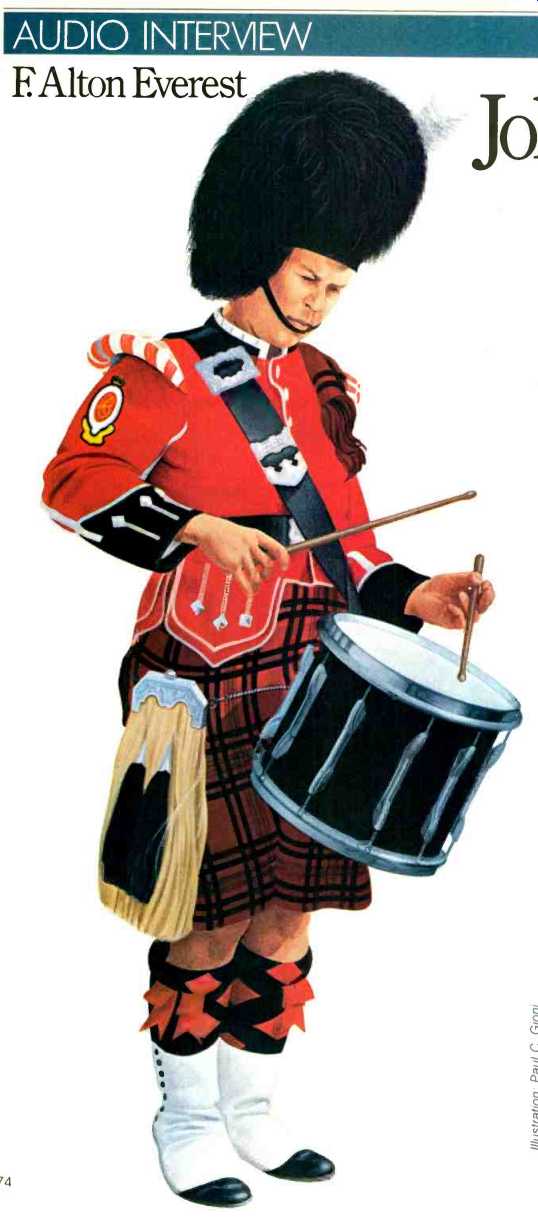
By F. Alton Everest
[Jack Cox, Senior Acoustical Engineer at International Jensen; Schiller Park, Illinois, USA ]
What was that fellow doing out there in the courtyard? He would clap his hands, listen intently, and then move, first toward and then away from the west wall of the old Smithsonian Building.
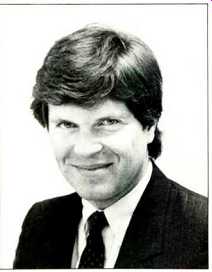
The year was 1854. The man was Joseph Henry. What he was doing was conducting the first psycho-acoustical experiment in what has become known as the "precedence effect" or the "Haas effect," although Henry was a hundred years before Helmut Haas.
Henry was listening for echoes of his handclaps from the side of the building. He found that when he was less than 30 to 40 feet from the building he heard no echo, but if farther than this a distinct echo was heard. He concluded that a delay of 1/20th to 1/16th of a second was necessary for the ear to distinguish between two successive sounds. For shorter delays the "echo" was fused with the original sound and was not discerned. Characteristic of Joseph Henry, he applied this important information in the design of an auditorium in the old Smithsonian Building on which Congress had asked him to collaborate.
Scores of researchers have dealt with this important aspect of human hearing, both before and after Haas 111 each making a contribution to the total fund of knowledge on the subject.
One of the latest contributions comes not from an established professor in a well-heeled psychology department but, rather, from the 1981 master's thesis of a 27-year-old electrical engineering student at the University of Colorado. The name on the thick thesis is John Charles Cox, but he answers readily to "Jack." He is now Senior Acoustical Engineer at International Jensen in Schiller Park, Illinois.
Jack was born in Evanston, Illinois, but, as a child, moved with his family to Janesville, Wisconsin, a small town south of Madison. Upon Jack's graduation from high school, his father, recently retired, decided that the family should move to Colorado Springs "to enjoy a more salubrious climate" (have you ever seen the records for cold weather and depth of snow in this part of the Rockies?). With characteristic vigor, Jack plunged into the academic program of the University of Colorado at Colorado Springs and Denver.
As it plays a central part in your research on the so-called Haas effect, tell us something of your background in music.
My major interest is music. I have been a drummer for almost 20 years now. I started in the public-school music program when I was in the fifth grade and participated in the public-school music program in concert band, jazz band, orchestra, and stage plays until I graduated from high school. In high school, I also played in a rock band called Tarsus, which achieved some notoriety and a little financial success. I marched with and was drum-section leader and percussion arranger for the Green Beret Marching Band of Janesville, Wisconsin. I have also marched with the Kilts Drum and Bugle Corps of Racine, Wisconsin. I was percussion instructor with the Boulder High School Marching Band and helped organize the first drum-line competition ever held in Colorado. Upon returning to the Midwest, I joined the Chicago Highlanders Bagpipe Band. Incidentally, my experience in participating, arranging, and judging the musical cleanness and uniformity of drum lines is central to my thesis because it has given me a unique training in perceiving echoes.
You did both your undergraduate and graduate work at the University of Colorado in electrical engineering. Did this signal a decreasing interest in music?
Not at all, quite the reverse. After three years on the Colorado Springs campus I moved to the Denver campus, and one of the reasons was the rapidly expanding Music School. Most of the second floor of the new Fine Arts Building housed a recording studio large enough to hold a full-sized symphony orchestra and chorus and two control rooms, each large enough to accommodate an entire class for witnessing a mixdown I took elective courses under Prof. Roy Pritts, who also directed the recording facility, along with the standard engineering courses. In this way I received hands-on experience in such things as recording, reinforcement, programming of synthesizers, musique concrete, etc.
Professor Robert Ashley, formerly of the University of Colorado and now with Sperry in Florida, has been considered by some as something of an iconoclast. Did your association with him lay the groundwork for a career of toppling traditional dogmas?
I have enjoyed my association with Bob Ashley, both as a professor of electrical engineering and as a friend. He got me interested in architectural acoustics, pointing out problems with coherent echoes in some of the concert halls and auditoriums in the Denver-Colorado Springs area. He planted the seed, as my advisor, and okayed my thesis subject, but he pretty much let me do my own thing. He does tend to be an independent thinker and it is very stimulating to be around him.
Why are echoes so important to you?
The first line of the first page of my thesis states, "Echoes are the most serious problem in architectural acoustics today." That says it! They garble announcements, ruin entertainment events, and profoundly inhibit the ability of entertainers to perform. Echoes are an extremely grave problem today, with great expanses of painted drywall surfaces in places of public assembly. Ornate interiors which create diffusion, as in Boston's Symphony Hall, are now fiscally prohibitive.
What stimulated your interest in psychoacoustics?
I became interested in psychoacoustics from my interest in music and found a big gap between that which is measured in engineering and that which is audible to the paying public.
There are things you can hear which can't be measured well; there are things you can measure and correct for that make no audible difference.
The ultimate test is not whether it has flat frequency response or is minimum phase or is time-aligned or any of those other buzzwords. It's whether it sounds good to the consumer who shells out the money. The big gap here can be closed only through psycho acoustical research.
Your master's thesis is entitled, "The Effects of a Single Echo on the Intelligibility of Speech and Music." This is very similar to the title of Haas's 1949 doctoral dissertation. Was it your intention to rerun Haas's experiments?
No, not at the beginning, but it became necessary to do so. The initial results of my thesis investigation were presented at the ICASSP [IEEE International Conference on Acoustics, Speech and Signal Processing] meeting in Denver in 1980 [2]. In my early literature search, it seemed that all references to single-echo effects pointed either to Georg von Békésy [3] or to Helmut Haas [4]. In studying Haas's paper, I found a lot of loose ends. The data was there, it just needed more coherent interpretation. Another reason for repeating Haas's experiments was that his work had been done back in 1949, with equipment quite primitive compared to the equipment I had.
What were you trying to find out?
I wanted to check two aspects of the influence of echoes, the effects of delay time and angle of incidence.
Haas had studied auditory forward inhibition, the tendency to integrate a direct sound with its echo. When two similar sounds are of equal amplitude, and one follows the other by 20 mS or less, you hear only the first sound, not the second, even though they are two distinct sonic events. This is the precedence effect, which is often called the Haas effect.
As to angle of incidence, it's been claimed that echoes coming at you in the same lateral plane as your head are more clearly perceived than those from higher or lower points. Many concert halls were built in the late '70s using this design philosophy of lateral reflections; they were, by and large, disasters, developing bad reputations very quickly.
Describe your research setup.
Envision a hemisphere with your seat at the center, a speaker right in front of you, plus another, movable speaker which carries the same signal as the fixed speaker, but delayed. You can move that second speaker to any point of the compass, and any angle of azimuth from ear level to directly overhead.
I set up such a system [Fig. 1] in my apartment. I checked carefully to make sure any echoes flying around the room were very low in level, comparable to Haas's situation on a roof. I measured these echoes or a storage 'scope, to be sure.
In my tests, I used drum taps as impulse test signals, fed them through a digital delay line [Fig. 2], and then to the amplifiers and speakers, with the movable speaker given the greater delay. It would have been simpler to delay only one signal, but I had to run both through the delay line to make sure that any hum, noise, or other side effects affected both signals equally.
My amplifiers, loudspeakers, and other components were of far higher quality than those available to Haas in 1949. He used a crude, analog tape delay device, while I used a high-quality digital delay line loaned by Mahlon Burkhard of Industrial Research Products. God bless his patience! I kept it two years!
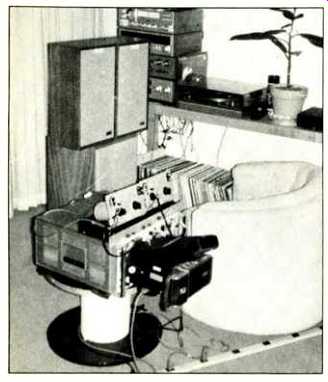
Fig. 1--Cox's test setup, here with delayed speaker in front of listening
position.

Fig. 2--Block diagram of Cox's test setup. (See text.)
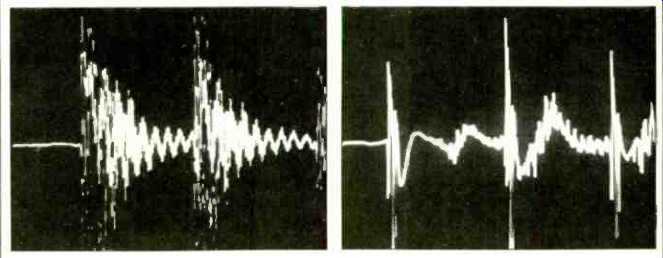
Fig. 3--Drum-tap waveforms.

Fig. 4--Sonic effects of signal delay, showing minimum detectable delay
(MDD) and maximum tolerable delay (MTD).
Why did you use drum taps as signals?
Well, von Békésy used rectangular envelope tone bursts. Haas used a talker speaking nonsense syllables but abandoned this in favor of continuous text so he could evaluate the effect of speed of speaking on intelligibility.
Both of these signals are so fraught with practical problems that I decided to use clear-cut, reproducible musical signals with which I was very familiar, percussion taps. I recorded myself playing on six different surfaces to get six different percussive timbres: Small and large wooden planks and a Remo practice pad with low and high tension, muffled and unmuffled. I used all these signals and averaged the results for the six different surfaces. It was easy to record signals of different repetition rates: For example, quarter notes (0.500 second/note), quarter-note triplets (0.333 second/note), and on down to 32nd notes (0.063 second/note), the fastest a percussionist is ever required to play.
And you were the listening jury?
Yes, primarily, although I used one corroborating listener. When you consider the vague and complex responses von Békésy and Haas required of their listeners, it is easy to account for the spread of their data and the statistical complexity required to offset it. It has been demonstrated that trained audio professionals are far more sensitive to transient intermodulation distortion than are laymen. So, I figured I could get more precise results with only myself as the listening jury.
An important point here is that all my experience in playing, teaching, and judging drum lines ideally fitted me to judge whether an echo 's present or not. In that drum line, if one player is a few milliseconds late, it is discernible to the trained, attentive ear. This is what drum-line competition is all about.
Now that we have all this background on techniques, procedures and equipment, what are the results of your research?
I have a problem here. I'm in the process of reporting the results of my tests to the scientific journals, and it isn't appropriate for me to jump the gun on them. However, there is no reason why general conclusions cannot be revealed at this time.
There are two distinct phenomena [Fig. 4], the minimum detectable delay (MDD) and the maximum tolerable delay (MTD). Let's take MDD first. The minimum detectable delay is the equivalent of what Beranek [5] called the "initial time delay gap," which is the time between the arrival of the sound from the stage and the arrival of the first reflection at a given seat in the audience. I found this to be 20 mS for drum-tap music for all but the very fast taps [Table I and Fig. 3]. Beranek found that concert halls receiving the highest ratings had initial time-delay gaps of 20 mS or less if used for symphonic music, which is precisely confirmed by my MDD. I think this is really significant. Here I was doing a purely psycho-acoustical test involving human perception, directly, and Beranek arrived at his conclusions indirectly, through opinions of concert-hall quality from experienced users of the hall. He did make physical measurements in each hall for correlation with opinions.
Dave Klepper of Klepper, Marshall, King talked to me about this. He was enthusiastic about Beranek's findings being confirmed through two very different methods and confirming his own 24-mS value for opera houses.
And how about MTD?
MTD is that delay at which drum taps, representative of music, become hopelessly confused and speech becomes unintelligible. I found this to vary from 20 mS for very fast drum taps to 84 mS for slow ones [see Table II].
As I studied your thesis it seemed to me that, perhaps, one of your major contributions was your pointing out what you call the "one-third rule."
Well, it sure makes it easy to predict the maximum tolerable delay. All you have to know is the musical staccato interval or the spacing of speech syllables. For example, English language spoken at a normal rate turns out to be about 5 syllables per second, which gives an interval between syllables of 1/5th of a second, or 200 mS. Dividing 200 mS by 3 gives a maximum tolerable delay of about 67 mS. This is very close to the way the measurements turn out [Table II], and it works on Haas's and von Békésy's data as well.
In general, your results seem to agree fairly well with Haas but not with von Békésy; is that right?
I couldn't verify von Békésy's assertion that there would be backward inhibition, that a delayed signal could erase our perceptions of the undelayed signal preceding it. My data simply did not support his conclusions: For delays of 4 to 12 mS, the undelayed-signal loudspeaker sounded much louder than the delayed-signal one, which Contradicts von Békésy. I understand that Blauert, in Germany, also observed auditory forward, but not backward, inhibition.
I did not know von Békésy was a Nobel laureate until minutes before I was going in to defend my thesis, and my knees almost folded. What would my committee think of an upstart like me contradicting a Nobel Prize winner?
Fortunately, one of the members of my committee, trained in psycho acoustics, could tell the others that I was not alone in questioning this particular conclusion of von Békésy, which came long after his Nobel Prize.
But, this is what science is all about, isn't it? Like Jack Webb used to say on TV, "Just give me the facts, ma'am."
The Haas effect is well recognized among hi-fi aficionados; will there now be a Cox effect?
[Laughter] I'll dodge the implications of that one and compare Haas's and my work. The precedence effect is my minimum detectable delay. What Haas really measured was the maximum tolerable delay. So, I feel that associating Haas's name with the precedence effect is ,incorrect. I should add that I consider the terms minimum detectable delay and maximum tolerable delay preferable to other terms which have been used, because they are clear and self-explanatory.
It is interesting to me that other researchers have had substantiation for the one-third rule right before them without pointing it out in their papers.
This is the rule that maximum tolerable delay is one-third the repetition rate of the events--one-third the time between notes in music, one-third the time between syllables of speech. With speech, of course, this must be the average over 1 or 2 minutes.
Okay, we will call this Cox's rule. Now, what is the significance of all this in the design of concert halls?
I hate to appear so negative, but t must question the whole philosophy that lateral reflections are more easily perceived than reflections from higher angles. Designing a concert hall based on this philosophy makes the hall very narrow and very shallow, so the initial time-delay gap of the lateral reflections is very short. Then, in order to get the necessary 2 uS reverberation time required for Romantic symphonies, the ceiling must be very high.
Haas researched this point and concluded there is no discernible difference in maximum tolerable delay, or what he called "critical transit time," with respect to echo angle of incidence. This means that it doesn't matter whether the echo comes from the side or from directly overhead; it is all the same. I have found the same thing for the minimum detectable delay, so we have all the bases covered there.
Reflections from the ceiling, balcony faces, rear wall, or side walls--all are important, and they can be just as disturbing.
If lateral reflections are more pleasant to hear, or are more acceptable to laymen because of past or present auditoria design, that is another question entirely. But I must point out that reaction from musicians and the paying public to auditoria designed on the lateral-reflection philosophy has ranged from apathetic to vitriolic. We may argue the fine points of acoustics, but it is the public that votes with its feet:
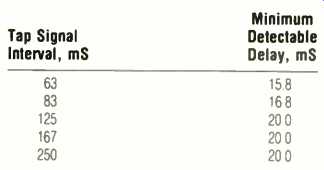
Table I--Minimum detectable delay (MDD) for delayed and undelayed signals
of equal level.
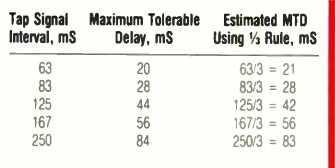
Table II--Maximum tolerable delay (MTD) for delayed and undelayed signals
of equal level.
References
1. Gardner, Mark B., "Historical Background of the Haas and/or Precedence Effect," Journal of the Acoustical Society of America, Vol. 43, No. 6 (June 1968), pg. 1243.
2. Cox, John Charles, "Time Delay Effects on Speech Intelligibility," Proceedings of the IEEE International Conference on Acoustics, Speech and Signal Processing, Fairmount Hotel, Denver, April 1980, Vol. 3, pg. 1034.
3. von Békésy, Georg, "Auditory Backward Inhibition in Concert Halls," Science, Vol. 171, No. 3971, pg. 529.
4. Haas, Helmut, "The Influence of a Single Echo on the Audibility of Speech," Journal of the Audio Engineering Society, Vol. 20, No. 2 (March 1972), pg. 146.
5. Beranek, Leo L., Music, Acoustics and Architecture, John Wiley & Sons, New York, 1962, pg. 586.
(adapted from Audio magazine, Jan. 1985)
Also see:
The Audio Interview: Telarc's Jack Renner--Recording Without a Net (July 1984)
The Audio Interview: Laurie Fincham--bass viol to bass driver (Jan. 1990)
The Certified Bass for the Certifiable (Jan. 1990)
The Audio Interview: Direct Reflections from Amar Bose (July 1983)
= = = =